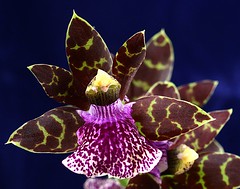Zygopetalum orchids have long history. In 1827, a Brazilian name Mackay gave an orchid to the famous orchid botanist, Sir William Hooker. Sir Hooker examined this unique new orchid and created a new genus for it: Zygopetalum. The first species of Zygopetalum orchids was named Zygopetalum mackayi in honor of that Brazilian gentleman. This genus derives its name from the Greek zygon (yoke) and petalon (petal), and is a perfect description of the growth at the base of the lip. These plants produce multiple blooms that can last for up to 8 weeks, and are often bred to be used as cut flowers.
Native to the mid-elevation regions of South America, Zygopetalum orchids are epiphytes and terrestrials. Because these orchids produce leathery strap-like leaves, they are often classified as “soft orchids. The leaves are apical and usually oblong. The pseudobulbs are conical or ovoid, deciduous, and produce 24 inch long inflorescences. The blossoms are usually 2 to 3 inches in diameter, racemose and grow laterally along the leaves. These blooms are known for the waxy look and feel and for their fragrance. Flowers come in a variety of colors, including green, purple, raspberry and burgundy.
Grow Zygopetalum orchids in a well-drained medium like fir bark in a warm sunny location. This genus likes bright light (3,000 to 4,000 foot candles), particularly morning and afternoon sun, but should avoid hot midday sun. As with other orchid genera, the leaves of this plant act as a light indicator. If the plant is getting the right amount of the sun, the leaves will be light green with just a touch of yellow. If the leaves are dark green, the orchid needs more sun.
Watering Zygopetalum orchids can be a bit of a balancing act. These plants like water, but don’t want to be soggy. They don’t want to be completely dry, either. Watering once a week is probably sufficient, but you should pay attention to heat and humidity, and adjust watering accordingly.
As natives of South America, particularly of Brazil, Zygopetalum orchids like warmth. In fact, these plants can take more heat than the average orchid, as long as it can have mild temperatures at night (50-65 degrees Fahrenheit). This orchid can tolerate cooler night temperatures, too, but only before it flowers. After that it should be kept in temperatures above 35 degrees, and should never be exposed to frost or freezing temperatures. In frost-free climates, such as Southern California, some species can be grown outdoors as long as they are protected from the hottest sun of the day.
Zygopetalum orchids do not go dormant, so they should be fed all year round. A balanced orchid fertilizer (20-20-20) is a good bet. Dilute to half strength and give to the plant at every other watering. The frequency of repotting depends on the type of medium. If your orchids live in bark, repot every year. If you’re using sphagnum moss, you can wait two years before repotting the plant. The best time to repot is immediately after all of the blooms have opened and are spent. Use a moist mix, and don’t press the medium too firmly into the pot. This orchid likes lots of air spaces.
Happy growing!
Photo courtesy of hbp_pix

